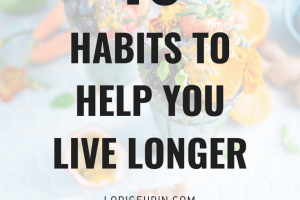Longevity Lifestyle: 10 Habits to Help You Thrive

Understanding Longevity and Lifestyle
As the world becomes increasingly aware of health and wellness, the pursuit of longevity has captivated many. Understanding the connection between lifestyle choices and how long we live can empower individuals to make informed decisions that promote a fulfilling and prolonged life. A well-rounded approach to longevity encompasses several key aspects, including:
- Longevity Lifestyle: 10 Habits to Help You Thrive
- Understanding Longevity and Lifestyle
- Prioritizing Nutrition
- Eating a Balanced Diet
- Importance of Hydration
- Regular Exercise Routine
- Benefits of Physical Activity
- Incorporating Strength Training
- Quality Sleep
- Creating a Restful Environment
- Practicing Good Sleep Hygiene
- Stress Management
- Mindfulness and Meditation
- Finding Work-Life Balance
- Social Connections
- Building Strong Relationships
- Participating in Community Activities
- Mental Stimulation
- Engaging in Lifelong Learning
- Challenges to Keep Your Brain Sharp
- Regular Health Screenings
- Importance of Preventive Care
- Monitoring Vital Health Markers
- Sun Safety
- Protecting Your Skin
- Vitamin D and Sun Exposure
- Healthy Aging Habits
- Embracing Positive Aging
- Adapting to Changes
- Nutrition: The foundation of health lies in the food we consume.
- Physical Activity: Regular exercise not only aids in maintaining a healthy weight but also boosts mental clarity.
- Sleep: Quality rest is crucial; it supports physical rejuvenation and cognitive function.
- Stress Management: Learning to navigate daily pressures can significantly impact one’s health.
For instance, consider a friend who transformed her life by adopting mindful eating practices and prioritizing exercise. She noticed not just improvements in her physical well-being but also a lift in her spirits. This serves as a reminder that small, consistent changes in our lifestyle can lead to significant achievements in our journey toward longevity.
Prioritizing Nutrition
Eating a Balanced Diet
Continuing the journey towards longevity, nutrition plays a pivotal role. Eating a balanced diet means fueling your body with the right mix of nutrients necessary for optimal health. It is all about variety and moderation. Incorporating different food groups ensures that you receive essential vitamins and minerals. A well-balanced plate could include:
- Fruits and Vegetables: Aim for a rainbow of colors—each color represents different nutrients.
- Whole Grains: Choose quinoa, brown rice, or whole grain bread over processed varieties.
- Lean Proteins: Opt for chicken, fish, legumes, or nuts.
- Healthy Fats: Avocado, olive oil, and fatty fish provide heart-healthy fats.
Importance of Hydration
Hydration is equally vital yet often overlooked. Water is a fundamental component of our body, playing essential roles in digestion, temperature regulation, and nutrient absorption. For example, a simple habit like carrying a reusable water bottle can encourage regular drinking throughout the day. Aim for:
- Eight 8-ounce glasses daily: This is a common guideline, but individual needs may vary.
- Colorful solutions: Herbal teas and infused water can add variety and make hydration more enjoyable.
By prioritizing both a balanced diet and proper hydration, individuals can significantly enhance their overall well-being and support their journey toward healthy aging.
Regular Exercise Routine
Benefits of Physical Activity
Building on the foundation of nutrition, regular exercise is another cornerstone of a healthy lifestyle. Engaging in physical activity has numerous benefits that extend beyond weight management. It enhances mental clarity, boosts mood, and can even improve sleep quality. Consider the various ways physical activity can impact your life:
- Cardiovascular Health: A brisk walk or a jog can strengthen the heart, reducing the risk of heart disease.
- Weight Maintenance: Combining exercise with a balanced diet helps manage body weight effectively.
- Enhanced Mood: Endorphins released during exercise can alleviate stress and anxiety.
Incorporating Strength Training
While aerobic exercises are essential, don’t overlook the importance of strength training. This type of exercise is crucial, particularly as one ages, to maintain muscle mass and bone density. To effectively incorporate strength training into your routine, consider these tips:
- Two to Three Times a Week: Aim for sessions that target all major muscle groups.
- Utilize Bodyweight Exercises: Push-ups, squats, and lunges can be done anywhere and don’t require equipment.
- Progress Gradually: Start with lighter weights and slowly increase as your strength builds.
By blending both aerobic exercises and strength training into a regular routine, individuals can enhance their physical and mental wellness, making strides toward a healthier, longer life.
Quality Sleep
Creating a Restful Environment
As we continue our journey toward a healthier lifestyle, we can’t overlook the significance of quality sleep. A restful environment plays a crucial role in achieving that deep, restorative slumber we all crave. To enhance your sleeping atmosphere, consider these tips:
- Optimize Your Bedroom: Keep it cool, dark, and quiet to promote better sleep.
- Quality Mattress and Pillows: Invest in comfortable bedding that supports your sleep position.
- Reduce Clutter: A tidy space can help clear your mind, making it easier to relax.
Practicing Good Sleep Hygiene
In addition to a conducive environment, practicing good sleep hygiene can dramatically improve the quality of your rest. Simple everyday habits can make a world of difference. Here are some pointers to follow:
- Consistent Sleep Schedule: Go to bed and wake up at the same time daily, even on weekends.
- Limit Screen Time Before Bed: The blue light from devices can interfere with melatonin production.
- Relaxation Techniques: Engage in calming activities like reading, or deep breathing exercises before sleep.
By creating a restful environment and practicing good sleep hygiene, individuals can enhance their sleep quality, leading to improved overall health and well-being, ultimately supporting their longevity journey.
Stress Management
Mindfulness and Meditation
As we delve deeper into the essentials of a healthy lifestyle, stress management emerges as a vital component of overall well-being. One effective strategy for managing stress is through mindfulness and meditation. These practices encourage individuals to live in the moment, reducing anxiety and promoting a sense of calm. Consider incorporating mindfulness into your daily routine. Here are some suggestions:
- Begin with Short Sessions: Start with just five minutes of meditation daily and gradually increase your time.
- Breathing Exercises: Focus on deep, rhythmic breaths to center your thoughts and relax.
- Mindful Activities: Engage fully in routine tasks, like enjoying a meal without distractions.
Finding Work-Life Balance
In addition to mindfulness, achieving a work-life balance is essential for managing stress. Many people struggle to juggle professional commitments with personal lives, leading to burnout. To foster balance, try these strategies:
- Set Boundaries: Designate specific work hours to protect your personal time.
- Prioritize Tasks: Use to-do lists to focus on what truly matters each day.
- Make Time for Hobbies: Engage in activities that bring you joy and help you recharge.
By integrating mindfulness practices and striving for a healthy work-life balance, individuals can effectively combat stress, paving the way for a happier, healthier life in their pursuit of longevity.
Social Connections
Building Strong Relationships
Continuing the exploration of a holistic approach to health, the importance of social connections cannot be overstated. Building strong relationships contributes significantly to emotional well-being and can even enhance longevity. Consider the impact of nurturing meaningful friendships:
- Emotional Support: Having a close circle to lean on during tough times can alleviate stress.
- Shared Joy: Celebrating milestones and life’s simple pleasures becomes even more fulfilling with loved ones.
- Healthier Habits: Engaging in group activities, whether it’s walking, cooking classes, or book clubs, promotes accountability and motivation.
Participating in Community Activities
Another way to foster social connections is by participating in community activities. Getting involved can expand your social circle and enrich your life in various ways. Think about these benefits:
- Volunteer Opportunities: Helping others not only builds connections but also enhances your sense of purpose.
- Local Events: Attend community festivals, art exhibits, or workshops to meet new people with shared interests.
- Clubs and Groups: Joining a local club can provide regular interaction, turning acquaintances into lasting friendships.
By focusing on building strong relationships and participating in community activities, individuals can cultivate a supportive network that enhances their overall well-being and contributes to a longer, more satisfying life.
Mental Stimulation
Engaging in Lifelong Learning
Transitioning from the importance of social connections, mental stimulation plays an equally significant role in maintaining both cognitive health and overall well-being. Engaging in lifelong learning is a fantastic way to keep your mind active. Whether it’s picking up a new hobby or diving into a subject of interest, there are myriad avenues for growth. Consider these options for lifelong learning:
- Online Courses: Websites like Coursera or Udemy offer thousands of classes on virtually every topic.
- Reading: Explore books, articles, or even podcasts that challenge your thinking.
- Language Learning: Try learning a new language—this not only engages your brain but can also open doors to new cultures.
Challenges to Keep Your Brain Sharp
In addition to formal education, actively seeking out challenges is a great way to boost mental acuity. Here are some effective approaches:
- Puzzles and Games: Engage in crossword puzzles, Sudoku, or strategy games that require critical thinking.
- Memory Exercises: Practice memorizing lists or numbers; it can be both fun and rewarding.
- Creative Outlets: Activities like writing, drawing, or playing a musical instrument often require unconventional thinking and can stimulate the brain.
By prioritizing lifelong learning and challenging the mind regularly, individuals can foster cognitive resilience, ultimately contributing to a vibrant and fulfilling life as they age.
Regular Health Screenings
Importance of Preventive Care
As we continue to discuss essential components of a healthy lifestyle, regular health screenings deserve paramount attention. Preventive care is invaluable in identifying potential health issues before they escalate. Scheduling routine check-ups can make a significant difference in achieving longevity and well-being. Consider these essential aspects of preventive care:
- Early Detection: Catching diseases such as diabetes or hypertension early allows for better management.
- Vaccinations: Staying updated on immunizations protects against various preventable diseases.
- Personalized Health Strategies: Regular screenings help tailor health plans based on individual risks.
Monitoring Vital Health Markers
Alongside preventive care, monitoring vital health markers is crucial for maintaining optimum health. Here are key markers to keep an eye on:
- Blood Pressure: High blood pressure can lead to serious conditions; regular monitoring is essential.
- Cholesterol Levels: Keeping track of these levels helps prevent heart disease.
- Blood Sugar Levels: Regular checks can help ward off diabetes and maintain overall metabolic health.
Emphasizing regular health screenings and monitoring vital health markers allows individuals to take charge of their health proactively. This proactive approach promotes not only longevity but also an enhanced quality of life.
Sun Safety
Protecting Your Skin
In our journey toward a healthy lifestyle, sun safety is a critical aspect that deserves special attention. While sunlight is essential for our well-being, overexposure can lead to skin damage and increase the risk of skin cancer. Therefore, protecting your skin is vital. Here are some effective ways to safeguard your skin from the sun:
- Apply Sunscreen: Choose a broad-spectrum sunscreen with at least SPF 30 and reapply every two hours, especially if you’re swimming or sweating.
- Wear Protective Clothing: Light, long-sleeved shirts and wide-brimmed hats can provide additional defense against harmful UV rays.
- Seek Shade: Take breaks in the shade during peak sun hours, typically between 10 AM and 4 PM.
Vitamin D and Sun Exposure
While protection is crucial, it’s also important to recognize the benefits of sunlight, particularly for vitamin D synthesis. Here’s how to balance sun exposure and skin safety:
- Moderate Exposure: Aim for around 10-30 minutes of sunlight several times a week on direct skin (without sunscreen) to facilitate vitamin D production.
- Dietary Sources: Complement sun exposure with foods rich in vitamin D, such as fatty fish, fortified dairy products, and egg yolks.
By prioritizing sun safety and being mindful of how to effectively balance skin protection with necessary sunlight for vitamin D, individuals can maintain their skin health while supporting their overall well-being as they age.
Healthy Aging Habits
Embracing Positive Aging
As we conclude our exploration of a healthy lifestyle, it’s essential to focus on healthy aging habits that encourage a fulfilling life. Embracing positive aging is about shifting perspective—seeing aging not as a decline but as an opportunity for growth and new experiences. Here are some ways to cultivate a positive mindset about aging:
- Celebrate Accomplishments: Reflect on and appreciate what you’ve achieved over the years, whether in personal or professional life.
- Stay Curious: Maintain an eagerness to learn and explore new interests, from travel to hobbies.
- Practice Gratitude: Regularly acknowledge the positives in your life; this mindset can improve overall emotional health.
Adapting to Changes
Aging inevitably brings changes—physically, mentally, and emotionally. Adapting to these transformations is key to maintaining resilience. Here are strategies to help navigate the changes that come with aging:
- Stay Flexible: Embrace change as an opportunity to learn and grow, rather than something to resist.
- Build a Support Network: Surround yourself with friends and loved ones who provide encouragement and understanding as you face new challenges.
- Prioritize Self-Care: Make self-care a priority by incorporating activities that promote both physical health and emotional well-being.
By embracing positive aging and adapting to changes gracefully, individuals can not only improve their quality of life but also enjoy the journey of growing older with confidence and vitality.



